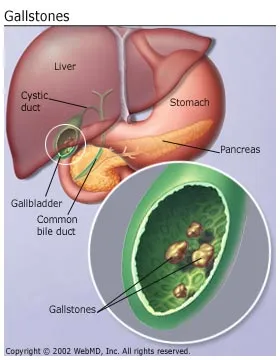What Are Gallstones?
They aren’t really stones. They’re pieces of solid material that form in the gallbladder, a small organ located under the liver.
You might not even know you have them until they block a bile duct, causing pain that you need to get treated right away.
Types:
The two main kinds are:Cholesterol stones. These are usually yellow-green in color. They’re the most common kind, accounting for 80% of gallstones.
Pigment stones. These stones are smaller and darker. They’re made up of bilirubin, which comes from bile, a fluid your liver makes and your gallbladder stores.

What Causes Gallstones?
There may be several reasons, including:
- Your genes
- Your weight
- Problems with your gallbladder
- Diet
Bile can be part of the problem. Your body needs bile, but if it has too much cholesterol in it, that makes gallstones more likely.
It can also happen if your gallbladder can’t empty properly.
Pigment stones are more common in people with certain medical conditions, such as cirrhosis (a liver disease) or blood diseases such as sickle cell anemia.
What are Risk factors?
You’re more likely to get gallstones if:
You’re obese. This is one of the biggest risk factors. Obesity can raise your cholesterol level and also make it harder for the gallbladder to empty completely.
You take birth control pills, hormone replacement therapy for menopause symptoms, or are pregnant. The extra estrogen is the problem. It can increase cholesterol and make it harder for the gallbladder to empty.
You have diabetes. People with this condition tend to have higher levels of triglycerides (a type of blood fat), which is a risk factor for gallstones.
You take medicine to lower your cholesterol. Some of these drugs boost the amount of cholesterol in bile, which may increase your chances of getting cholesterol stones.
You lost weight too quickly. Your liver makes extra cholesterol, which may lead to gallstones.
You’re fasting. Your gallbladder may not squeeze as much.
What Are the Symptoms?
You might not notice anything, or even know you have gallstones, unless your doctor tells you. But if you do get symptoms, they usually include:
- Pain in your upper belly and upper back that can last for several hours
- Nausea
- Vomiting
- Other digestive problems, including bloating, indigestion and heartburn, and gas
What’s the Treatment?
Many people with gallstones get surgery to take out the gallbladder. There are two different kinds of operations.
Laparoscopic cholecystectomy. This is the more common procedure. The surgeon passes instruments, a light, and a camera through several small cuts in the belly. He views the inside of the body on a video monitor. Afterward, you spend the night in the hospital.
Open cholecystectomy. The surgeon makes bigger cuts in the belly to remove the gallbladder. You stay in the hospital for a few days after the operation.
If gallstones are in your bile ducts, the doctor may use ERCP to find and remove them before or during gallbladder surgery.

Post a comment